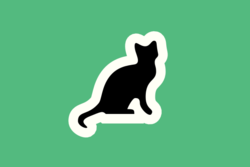Snaiwdene: Difference between revisions
mNo edit summary |
mNo edit summary |
||
| (5 intermediate revisions by 3 users not shown) | |||
| Line 1: | Line 1: | ||
{{Nation | |||
|country = Snaiwdene | |||
|image_flag = Flag snaiwdene.png | |||
|language = [[Tunge]] | |||
|capital = Snaiwdene | |||
|largecity = | |||
|website = | |||
|forum = | |||
|population = | |||
|active = | |||
|date_founded = | |||
|government = Autonomous anarcho-syndicalist collective. | |||
|leader = | |||
|currency = | |||
|animal = | |||
|fruit = | |||
|drink = | |||
|image_map = Snaiwdene_claim 2.png | |||
|maps = | |||
}} | |||
[[File:Snaiwdene yurt.png|thumb|right|Picture of a yurt in the village of [[Snaiwdene]]]] | [[File:Snaiwdene yurt.png|thumb|right|Picture of a yurt in the village of [[Snaiwdene]]]] | ||
'''Snaiwdene''' is a village and nation, originally on the island [[Auwjuland]] but currently on [[Murder]], that acts as the refuge of the [[Kattuz]], a human-feline hybrid people that was the result of genetic experimenting done by the Jingdaoese [[Imperial Armed Forces]]' [[Unit 666]] in order to create superhuman soldiers. | |||
The name Snaiwdene means ''snowy valley'' in [[Tunge]], the language of the Kattuz. | |||
== History == | |||
Like mentioned before, the kattuz were the result of genetic experimenting done by the Jingdaoese Unit 666. As the project was cancelled and the kattuz were to be euthanised, they broke out of the Unit 666 compound and fled to Snaiwdene. From 1705 to 1712 Auwjuland was claimed by the [[Community of Pacary]], which was predominantly settling on the northern island, also known as Pacary, and the kattuz had to lay down to avoid detection. In 1711 an extremely cold winter made the island of Pacary uninhabitable and the Community of Pacary was evacuated to Sanpantul. Halfway 1712, as the kattuz were confident that the [[Paqalinuit]] and [[Nunaqeqertaquit]] people had left the area, they began to re-appear from their places of hiding. However, in XII.1713 the Micras Cartography Society voted against admitting the nation on its claimsmap, blocking the way for international recognition of the kattuz. | |||
In 1723 the kattuz noticed the fall of human civilisation on the island of Murder. That had previously been occupied by witches collaborating with demonic powers. As the demonic powers waned, some of the kattuz, who had been laying in hiding in the south of the island in a small town called [[Niwjaz Snaiwdene]] sent a meow for help to the other kattuz in the diaspora, to seek to conquer the island and drive off the remaining witches. | |||
== Demographics == | |||
As of XIII.1723, Snaiwdene is home to approximately 5,000 kattuz living in yurts in the city, but oftentimes travelling over the rest of Micras as traders. | |||
== Politics == | |||
The village does not have a political system, as the feline genes of the kattuz make following authority wholly unnatural to them. The village does however have a hospital that cares for the sick and is funded by voluntary donations, as well as several schools for the younger members of society. In periods of war, the kattuz have the custom to elect a war-leader that will command them all for the duration of the war, but will hold no power afterwards. | The village does not have a political system, as the feline genes of the kattuz make following authority wholly unnatural to them. The village does however have a hospital that cares for the sick and is funded by voluntary donations, as well as several schools for the younger members of society. In periods of war, the kattuz have the custom to elect a war-leader that will command them all for the duration of the war, but will hold no power afterwards. | ||
[[category:Nations]] | [[category:Nations]] | ||
[[category:Snaiwdene]] | [[category:Snaiwdene]] | ||
[[category:Murder]] | |||
[[Category:Cities]] | |||
Latest revision as of 08:33, 26 August 2023
 | |
| Official language | Tunge |
|---|---|
| Capital | Snaiwdene |
| Government | Autonomous anarcho-syndicalist collective. |
 | |

Snaiwdene is a village and nation, originally on the island Auwjuland but currently on Murder, that acts as the refuge of the Kattuz, a human-feline hybrid people that was the result of genetic experimenting done by the Jingdaoese Imperial Armed Forces' Unit 666 in order to create superhuman soldiers.
The name Snaiwdene means snowy valley in Tunge, the language of the Kattuz.
History
Like mentioned before, the kattuz were the result of genetic experimenting done by the Jingdaoese Unit 666. As the project was cancelled and the kattuz were to be euthanised, they broke out of the Unit 666 compound and fled to Snaiwdene. From 1705 to 1712 Auwjuland was claimed by the Community of Pacary, which was predominantly settling on the northern island, also known as Pacary, and the kattuz had to lay down to avoid detection. In 1711 an extremely cold winter made the island of Pacary uninhabitable and the Community of Pacary was evacuated to Sanpantul. Halfway 1712, as the kattuz were confident that the Paqalinuit and Nunaqeqertaquit people had left the area, they began to re-appear from their places of hiding. However, in XII.1713 the Micras Cartography Society voted against admitting the nation on its claimsmap, blocking the way for international recognition of the kattuz.
In 1723 the kattuz noticed the fall of human civilisation on the island of Murder. That had previously been occupied by witches collaborating with demonic powers. As the demonic powers waned, some of the kattuz, who had been laying in hiding in the south of the island in a small town called Niwjaz Snaiwdene sent a meow for help to the other kattuz in the diaspora, to seek to conquer the island and drive off the remaining witches.
Demographics
As of XIII.1723, Snaiwdene is home to approximately 5,000 kattuz living in yurts in the city, but oftentimes travelling over the rest of Micras as traders.
Politics
The village does not have a political system, as the feline genes of the kattuz make following authority wholly unnatural to them. The village does however have a hospital that cares for the sick and is funded by voluntary donations, as well as several schools for the younger members of society. In periods of war, the kattuz have the custom to elect a war-leader that will command them all for the duration of the war, but will hold no power afterwards.